by Robert Lipsett, Site Leader and Engineering Manager, Thomson Industries
Here we explain where leadscrews excel in linear-motion applications. Then we explain how to apply them.
Ballscrews are often the first choice for linear-motion applications because the use of recirculating ball bearings provides high efficiency, load capacity and positioning accuracy. However, with careful attention to selection and application, leadscrews can deliver efficiency that comes close to ballscrews on many applications—as well as high load capacity and positioning accuracy. What’s more, engineers can more easily tailor leadscrews to applications, thanks to a flexible configuration and form factor, the ability to operate without lubricant, quieter operation and lower cost.
Leadscrews use the helix angle of the thread to convert rotary motion to linear motion. Leadscrew performance is heavily dependent on the coefficient of friction between the nut and the screw, which in turn depends upon the material of the nut and screw. Leadscrews typically use nuts made of internally lubricated plastic or bearing-grade bronze. Plastic nuts usually travel on stainless-steel screws, while bronze nuts often run on carbon steel screws. With bearing-grade bronze nuts, stainless-steel screws are an option.
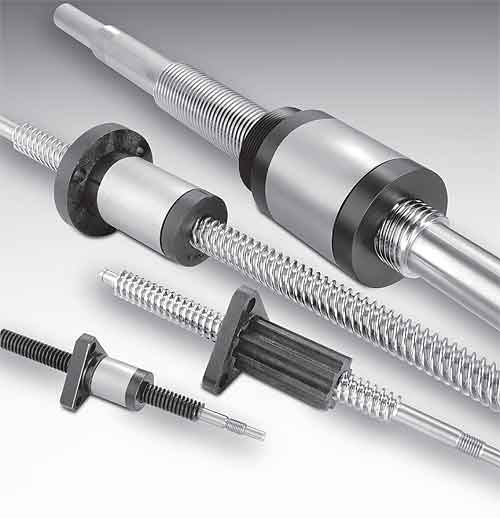
Engineers can determine if leadscrews are a good fit for an application (and select the most appropriate leadscrew features) in a few simple steps.
Leadscrew load capacity
In considering whether leadscrews or ballscrews are the best for an application, begin by looking at the required load capacity. Plastic nuts are suitable for light loads of less than 100 lb, although plastic nut designs for 300 lb and beyond are possible. Bronze nuts, on the other hand, are useful for applications in excess of several thousand pounds. Ballscrews generally provide equal or better load capacity than leadscrews, so are a better choice if load requirements exceed leadscrew capabilities.
Leadscrew efficiency
Ballscrews offer higher efficiency because rolling contact provides a lower coefficient of friction than sliding contact. The efficiency of ballscrews is relatively constant and is typically better than 90%. In contrast, the efficiency of leadscrews typically ranges from 20 to 80% … a value highly dependent upon helix angle. Helix angle is the arctangent of the lead divided by the pitch diameter. It is the angle of advancement of the thread. As a general rule, higher helix angles mean higher efficiency. A higher helix angle is more efficient because less of the energy driving the leadscrew goes into overcoming friction. This is because the number of times the screw must rotate to get a given linear displacement is lower on a high helix screw. One disadvantage of high helix angle is that it necessitates more torque to turn the screw.
Note that when the efficiency of a leadscrew exceeds 50%, the leadscrew becomes back-drivable, which means it can be driven backward by the load. Back-drivability is a disadvantage in many applications because its forces engineers to incorporate a brake to support the load … especially if the screw mounts vertically.
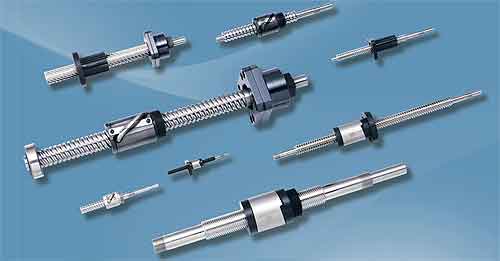
On the other hand, back-drivability is a plus in some applications. For example, one requirement for many doors in passenger railcars is that they let riders force them open. Here, door engineers can configure the drive with a high helix angle leadscrew so that a motor can rapidly close the doors … and passengers can get out during an emergency.
Leadscrew speed
Ballscrews are commonly available in medium leads between 0.200 to 0.500 in./rev, although high-helix products exist. Leadscrews come in a wide range of leads, from less than 0.050 to 2.00 in./rev or more. The use of a wide range of leads can deliver a wide variation in jog speeds up to 70 in./sec. This leadscrew feature can provide advantages in many applications. For example, devices that must accurately position payloads can use a leadscrew with a low helix angle to get high positioning resolution. Other applications benefit from fast jog speeds and low screw rpm, providing quiet operation and long life. The maximum rotational speed of a leadscrew is limited by the critical speed of the screw—the speed at which resonance occurs. Leadscrew nuts can be driven at very high rpm, but depending on the applied load, heat buildup may occur, which in turn limits duty cycle.
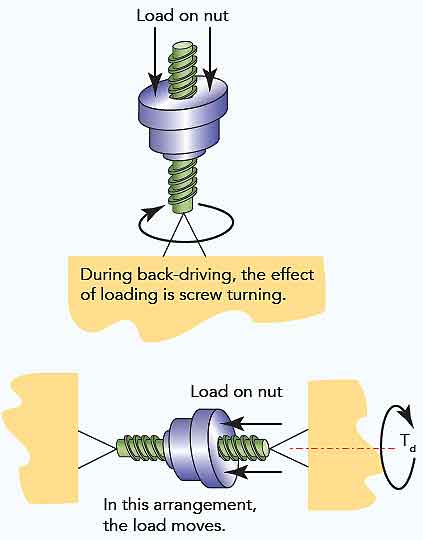
application needs backdriving functionality, leadscrews can deliver it, too … the designers must simply pick a lead that’s greater than one-third the screw diameter. (Ideally the lead is equal to or larger than the screw diameter.)
The critical speed of the screw shaft also limits ballscrews, and these linear-motion devices are also limited by how fast the balls can travel through the nut returns without damaging the components. This is known as the DN rating.
Leadscrew duty cycle
Ballscrews easily provide constant motion at load … and because they generate low frictional heat, their duty cycle is practically unlimited. In contrast, plastic and stainless-steel leadscrew assemblies are typically limited to a duty cycle of 50% under the rated load. Leadscrew assemblies that use bronze nuts have higher load capacities, but these heavier loads increase frictional heat so their duty cycles must be lower, often as low as 10%. This can be calculated more accurately using the PV relationship. (Refer to the section in this article titled, “A final note on the pressure-velocity factor” for more information.) Leadscrews can operate at 100% duty cycle at light loads and moderate speeds, or they can run at lower duty with either high load and low rpm or low load and high rpm, but not both. High load and high rpm relative to a given thread size and nut design causes overheating and failure.
Leadscrew backlash
Backlash is significant consideration in applications where positioning accuracy is important. Standard ballscrew and leadscrew configurations typically have backlash ranging from 0.002 to 0.010 in. Anti-backlash lead nuts eliminate free play and increase repeatability. Most designs place a compression spring or other compliant member between two nut halves to remove radial clearance. Preload between the nut halves must equal or exceed the applied axial load in the direction in which the assembly is loaded through the take-up mechanism to prevent lost motion. The result is a higher torque requirement which typically necessitates a larger motor.
Some proprietary anti-backlash nuts remove free play between a nut and screw without introducing excessive drag torque. Cam surfaces on a biasing spacer let it rotate and translate relative to the mating nut halves, accommodating clearances from wear of the nut threads. The angle of the cam surfaces let the two parts self-lock, preventing ramp down or backlash from developing under load. A torsional spring inside the cam between the half-nuts provides sufficient torque for nut biasing. Only when wear at the nut-thread interface creates clearance will the cam advance to eliminate backlash. The self-locking action prevents cam movement except during load reversals.
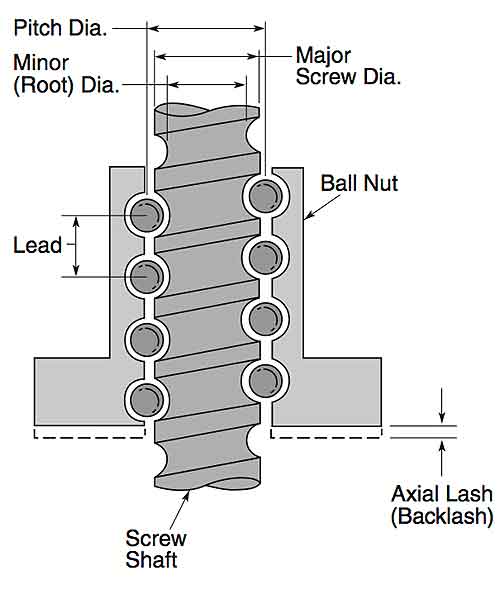
lead nuts eliminate freeplay and increase repeatability.
Leadscrew noise
Ballscrews are prone to a certain amount of noise because of ball-bearing recirculation. On the other hand, leadscrews are quiet … although frictional impedance from sliding can produce chatter or squeal in the absence of lubrication.
Leadscrew corrosion resistance
Ballscrews made of carbon steel (a common choice) may be sensitive to certain corrosive environments. On the other hand, leadscrews with a stainless-steel screw and plastic nut or are highly corrosion resistant. However, the plastic nut may be limited to temperatures between 30 and 150° F. Leadscrews with a stainless-steel screw and bronze nut also resist corrosion well.
Leadscrew design freedom and cost
Ballscrews have a relatively rigid form factor. In contrast, leadscrews give engineers more design freedom. Designers can pick from myriad form factors and helix angles to optimize them to application requirements. In addition, the cost of a new ballscrew design is typically $10,000 to $20,000 versus $3,000 to $5,000 for a comparable leadscrew.
Leadscrew life calculations
There is no reliable closed form solution for calculating the life of a leadscrew because wear from friction can be nonlinear. A single wear coefficient is often insufficient to predict performance throughout the life of a leadscrew assembly. Life is estimated by case study under controlled operating conditions. In the case where the combination of loading, speed and duty cycle exceeds a certain limit, failure is predictable and will occur rapidly. For applications that operate near the recommended design load at greater than 500 rpm, check with the applications engineering department of your leadscrew supplier. They can calculate the pressure velocity (PV) factor, which is a key design factor in proper sizing and selection of leadscrew assemblies that use polymer nuts.
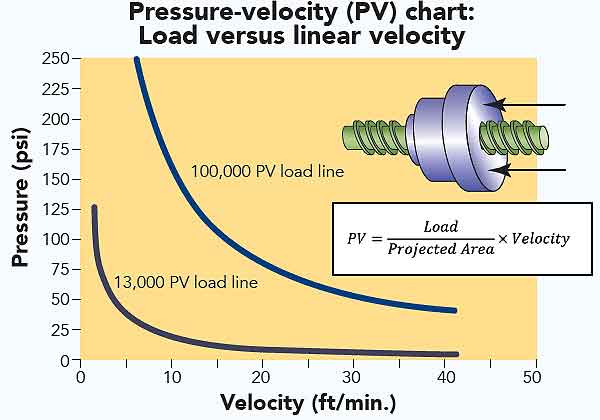
A final note on the pressure-velocity factor
The PV factor is the product of the pressure and velocity between the nut and screw. It helps determine the load, speed and duty cycle that the nut can handle. Plastic materials have an intrinsic PV rating, the point at which frictional heat causes permanent deformation of the plastic. So, the more load applied to a leadscrew assembly, the slower it must be turned to avoid exceeding the nut’s PV limit. Likewise, the faster the nut is turned, the lower the available load capacity. The primary modes of failure for plastic nuts are wear and PV. Wear failure occurs more slowly than a PV failure and can be accounted for through application of case studies and testing.
Leadscrew lubrication
All ballscrews need lubrication to provide reasonable life. Leadscrew mechanisms using bronze nuts also need lubricant, usually in the form of a thick damping grease. In contrast, leadscrew assemblies with plastic nuts can run well without lubricant due to the internal lubricants in the nut material, but the use of gel-type lubricant increases allowable loading and extends life by reducing friction between nut and screw. For moderate loading, speed and duty cycle in an office environment, lubrication should last between 500,000 and 2,500,000 in. Harsh environments reduce grease life. Tip for end users: If particulate is present, clean the screw before reapplying lubricant. Reapply when there is no visible film remaining on the flanks of the screw thread.
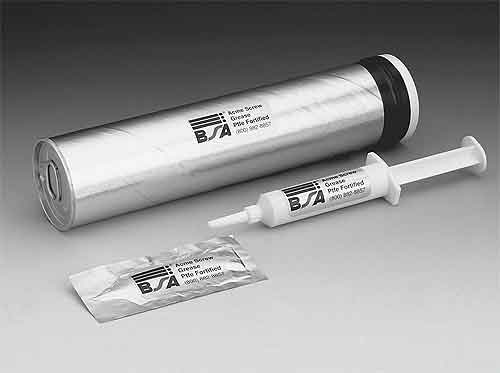
More guidelines: Don’t use grease in environments with significant particulate or debris that can load the grease and turn it into abrasive slurry. In this type of application, use dry-film lubricant instead. PTFE coating is a dry film that creates a lubrication barrier between a metal substrate and a polymer bushing or lead nut. It is suited for use with plastic nuts and stainless-steel leadscrews. Such pairings eliminate the need for lubrication maintenance … and the coating does not attract particulate like a gel lubricant.
Online selection and sizing
Today, online tools greatly reduce the time engineers need to spend on picking a suitable leadscrew. In some cases, the user enters key application parameters, including mounting configuration, loading conditions, life requirement, orientation, speed and stroke. The online software then filters choices with a comprehensive set of calculations. Then it presents a listing of products that meet the application requirements ranked by smallest to largest screw size. Users can further filter results on parameters such as accuracy, repeatability, environment and nut style. Outputs include product specifications, dimensions, 3D models, quote request form and ordering information.
Thomson Industries
www.thomsonlinear.com


Leave a Reply
You must be logged in to post a comment.